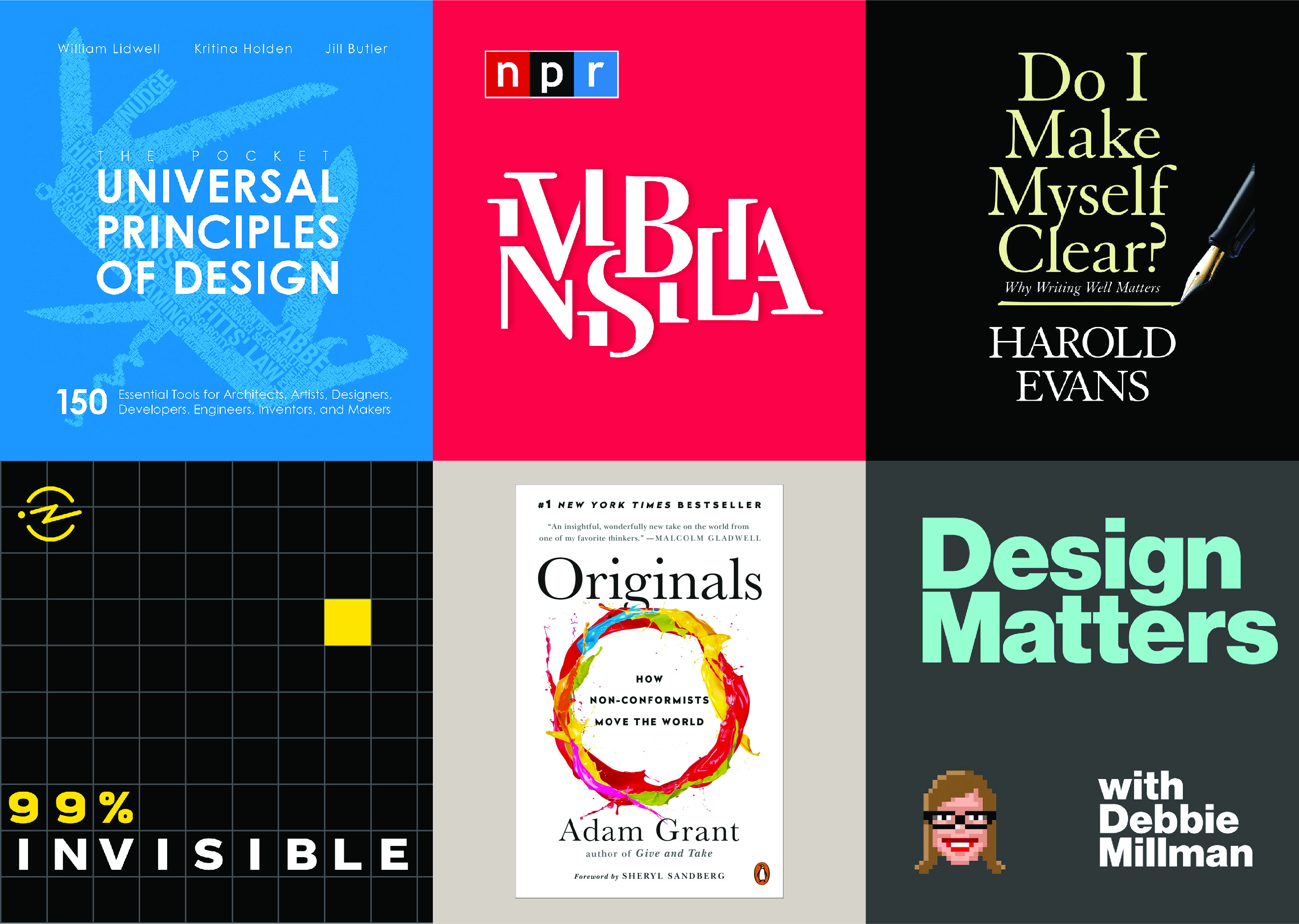Our favorite writing, design, and marketing resources

If you’re like us, you’re always looking for new techniques and trends to improve your work. So we thought we’d share a list of the design, marketing, and writing resources that are either inspiring us right now or that we return to again and again.
Books:
Designing for People – Henry Dreyfuss
Written by my idol and one of the founding fathers of the industrial design industry, this book explains why users are central to design. Dreyfuss developed the notion of “users” long before the Internet existed. And he talked a lot about why it’s important to bring good design to the masses, long before Target used it to turn the company into a household brand. — Shelley Batuyong, Senior Design Director
Do I Make Myself Clear?: Why Writing Well Matters – Harold Evans
In our content-laden world, clear writing is often hard to come by. In this clever and entertaining book, Evans, a former editor of the Sunday Times, rails against obfuscation in corporate writing and elsewhere. His examples of concise prose can help you polish your own copy. — Jeannine DeFoe, Senior Financial Writer & Strategist
Universal Principles of Design – William Lidwell
This book examines the science and psychology behind all forms of design, and puts names to some of the principles that it’s taken me 25 years to arrive at organically. It’s a great resource for designers in all fields, both to improve their skills and to defend their work. — Elizabeth Amorose, Partner
Originals: How Non-Conformists Move The World – Adam Grant
I find myself referring to this book frequently when working on various production, strategy, and marketing projects. Grant dives into disruptive ideas from the last 50 years to discover not only how the concepts were developed, but also how we can implement similar principles in our work today. — Marylou Lalu, Project Coordinator
The Visual Display of Quantitative Information – Edward Tufte
This has rightly become a classic text — both as an effective how-to (and how-not-to) for designers and editors, and as a common-sense guide to conveying information on the page more efficiently and effectively. For me, it’s Tufte’s thinking about how words, data, and pictures — things we often think of as distinct from each other — work together to create rich, revealing, and delightful information graphics. — Jay Sherman-Godfrey, Financial Editorial Director
Draft No. Four: On the Writing Process – John McPhee
This book is a master class on the writing process, told through a series of playful essays. McPhee, a professor at Princeton and long-time writer for The New Yorker, shares valuable and entertaining insights on processes including structure, editing, and revising. — Carolyn Grace, Writer & Strategist
Creative Quest – by Questlove
There’s a whole industry of books that examine the creative process, but only a handful of them are written by working artists. As a Roots fan, it was cool to get a behind-the-scenes look from the group’s founder on how some of their songs were created, and what it’s like to collaborate with other artists of similar and different disciplines. — Chris Riely, Design Director
Podcasts:
This podcast covers everything from graphic design to architecture to system design, focusing on what typically goes unnoticed. Their website is worth checking out as well; it features articles that never made it into audio format. — Brett Traylor, Partner
In this long-running show, designer and author Debbie Millman interviews creative professionals from a variety of industries. I enjoy listening to the reflections each individual shares on the influential moments and milestones that helped lead them to where they are today. — Brianna Sykes, Senior Project Manager
This NPR podcast offers an unconventional look into the invisible forces that shape human behavior — thoughts, emotions, social norms, even clothing. Each episode challenges the listener to interrogate their thinking around a supposedly universal “known.” I’ve found it very helpful in shifting my perspective on how I typically describe a person or topic of interest. — Carolyn Grace
Blogs & Websites:
This is a web design gallery that aggregates the best web designs featured on other blogs, such as Awwwards, Klikkentheke, and Typewolf. What’s great about this site is that you don’t have to review each design one by one — you can click on any thumbnail to go directly to that website. — Olive Miller, Senior Digital Designer
This is my go-to for information about design, and a great resource when you have time to dig through the site. — David Robinson, Senior Designer
Digiday UK, TechCrunch, and The Verge
I find these three sites to be great resources to help me keep up with everything going on in the digital world. I read Digiday UK, in addition to their US site, to make sure I’m getting a global perspective. — Marylou Lalu
This site is dedicated to highlighting exceptional consumer and corporate brand design, and offers a collection of visual candy as well as interviews. — Chris Riely
This website emphasizes good design as shown through posters. Because at the end of the day, it’s all about the typography. — David Robinson
This simple, crowd-sourced thesaurus site comes in handy when you’re looking for a broader range of synonyms, which wouldn’t be found in proper thesauri. — Elizabeth Amorose
I always find insightful articles and how-to guides on editorial strategy, distribution, and the value of good content. — Jeannine DeFoe
Though the reviewers on this roundup of corporate and brand identity work can be snarky, I still find the website to be a valuable source for branding insights. — Chris Riely